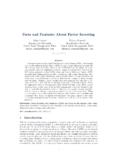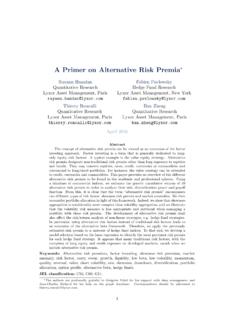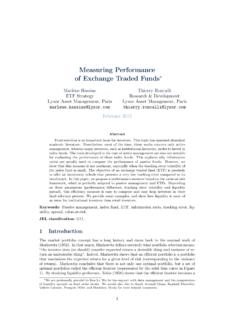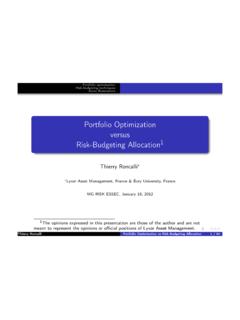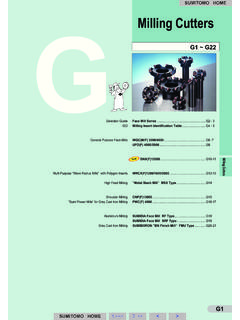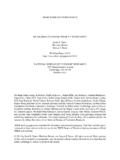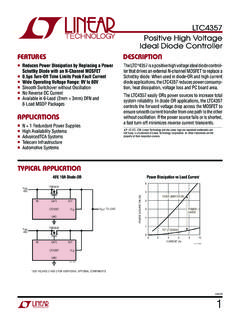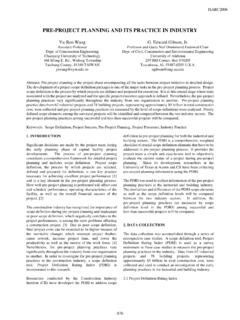Transcription of Financial Applications of Copula Functions - Thierry Roncalli
1 Financial Applications of Copula FunctionsJean-Fr ed eric Jouanin, Ga el Riboulet and Thierry RoncalliGroupe de Recherche Op erationnelle, Cr edit Lyonnais, FranceAbstractCopula Functions have been introduced recently in finance. They are a general tool to constructmultivariate distributions and to investigate dependence structure between random variables. In thispaper, we show that Copula Functions may be extensively used to solve many Financial problems. Asexamples we show how to them to monitor the market risk of basket products, to measure the credit riskof a large pool of loans and to compute capital requirements for operational Classification:G10 Key words: Copula , risk management, market risk, credit risk, operational risk1 IntroductionOne of the main issues in risk management is the aggregation of individual risks.
2 This problem can beeasily solved or at least discarded by assuming that the random variables modelling individual risks areindependent or are only dependent by means of a common factor, so that we can reduce to the case ofindependent variables, by eventually adding one new variable (describing the common factor) to the set ofthe problem becomes much more involved when one wants to model fully dependent random variables or,when one does not know what the exact joint distribution is, to produce a large set of dependence betweenthe given individual risks. Again a classic solution is to assume a Gaussian behavior of the vector of risks(with some given covariance matrix); however, all risks are not likely to be well described by a Gaussiandistribution think of the distribution of the loss of a pool of credit which is highly asymmetric or theNormal joint distribution may fail to catch some exotic key features of the dependence of the studied risks a tail dependence.
3 Besides, we stress that we do not often have as much information on the jointdistribution as that on each separate powerful and user-friendly tool to describe dependent risks is provided by the concept ofcopula. Acopula is nothing else but the joint distribution of a vector of uniform random variables. Since it is alwayspossible to map any vector of s into a vector of s with uniform margins, we are able to split themargins of that vector and a digest of the dependence, which is the Copula (that is roughly the meaning ofSklar s theorem). The concept of Copula was introduced bySklar[1959] and studied by many authors suchasDeheuvels[1979],GenestandMacKay[19 86]. Details and complete references are provided by thebooks ofNelsen[1999],Joe[1997] and alsoHutchinsonandLai[1990].With the concept of Copula we are given plenty of families of Functions (Student, Gumbel, Clayton, etc.)
4 That enable us to produce a richer dependence than the usual Gaussian assumption; and Sklar s lemma tellsus how to impose one form of dependence between random variables with given margins. But we stress thatthis does not give any hint on how to choose the dependence to input between the random variables, whichmay be seen as a severe shortcoming of the Copula approach. While the assumption of Gaussian dependencecan be considered as quite natural, we need now to motive any choice of a particular family of copulas, incases where it is not easy to decide because of the frequent lack of information on the dependence. Yet, in1the practice of banks until now, the choice of the Copula when not purely arbitrary is justified ratherby convenience and tractability arguments (Student and Fraitly families are often easy to simulate in aMonte-Carlo methodology) than a thorough analysis of the risks to be goal of this survey paper is to provide some simple Applications of copulas for risk management froman industrial point of view.
5 First, we remind some basics about copulas. Then, some Applications of copulasfor market risk, credit risk and operational risk are given. A special attention will be paid to credit riskmodelling since we think the Applications of copulas have been the most successful in this field until will not lay the emphasis on the various concepts of dependence and correlations which were clarified ina sparkling manner byEmbrechts,McNeilandStraumann[2002].2 Copula FunctionsWe will not provide a full mathematical treatment of the subject here and we refer interested readers toNelsen[1999], from which the following results are drawn. For short, we also choose to stick to the bivariatecase but it is easy to generalize definitions to then-dimensional case. Mathematically speaking, a functionC: [0,1]2 [0,1] is acopula functionif it fulfills the following increasing in the sense that for 0 u1 u2 1 and 0 v1 v2 1 we haveC([u1, v1] [u2, v2]) C(u2, v2) C(u2, v1) C(u1, v2) +C(u1, v1) 0; (1, u) =C(u,1) =uandC(0, u) =C(u,0) = 0 for allu [0,1].
6 Thus, we may interpret a Copula function as a cumulative probability function of two uniform randomvariables (U1, U2). Now letF1andF2be any two univariate distributions. It is obvious to show thatF(x1, x2) C(F1(x1), F2(x2))is a probability distribution, the margins of which are exactlyF1andF2. We say that it is a distributionwith fixed (or given) marginals. Conversely, Sklar proved in 1959 that any bivariate distributionFadmitssuch a representation and that the copulaCis unique provided the margins are illustrate the idea behind the Copula function, we can think about the bivariate Gaussian state that a random vector (X1, X2) is Gaussian is equivalent to state univariate marginsF1andF2are Gaussian; margins are linked by a unique Copula functionC(called theNormalcopula) such that:C(u1, u2; ) = ( 1(u1), 1(u2) ; )= u10 ( 1(u2) 1(u) 1 2)duwith the standard univariate Gaussian cumulative distribution and (x1, x2; ) the bivariateNormalcumulative function with correlation.
7 A very important special case ofNormalcopula family is obtained with = 0: it is theproduct copulaC (u1, u2) u1u2. Of course, two variables are independent if and only if their Copula is the exists many other Copula families: most of them are obtained like theNormalfamily by inversionfrom well known bivariate distributions an example which is important in risk management is theStudentcopula, that is the Copula function of the bivariate Student tdistribution , but we also know direct methodsto construct new copulas: the most famous family of this kind is no doubt theArchimedean copulasC (u1, u2) 1( (u1) + (u2))2with : [0,1] R+a convex, continuous, decreasing function such that (1) = 0. Again an importantexample is theGumbelcopula where we set (t) ( logt) with Copula decomposition may be used to extend univariate models to multivariate models.
8 Let usconsider a simple example with two random distributed according to an InverseGaussian distribution and a Beta distribution. If we consider classic handbooks on multivariate distributions([26] for example), it is difficult to find a bivariate distribution with such margins. Figure 1 correspondsto a bivariate distribution with aNormalcopula1. This example might be an illustration of a credit riskFigure 1: An example of bivariate distribution with given marginalsmodelling be a default time andX2a recovery rate. The dependence between the tworandom variables are introduced through a Copula function. The Copula method is also very powerful froman industrial point of view risk can be split into two parts: the individual risks and the dependence structure between them, the dependence structure may be defined without reference to the modelling specification of indi-vidual of thissequentialapproach, the Copula framework enables in this way to solve some the paper [13], the authors discuss many concepts of dependence and correlation.
9 We remind here themost important results. LetX= (X1, X2) be a bivariate random vector. We define the copulaC X1, X2 of the random variablesX1andX2as the Copula of the corresponding bivariate [1981] show that the Copula function is invariant under strictly increasing transformations. Itmeans that if the functionsh1andh2are strictly increasing, the Copula of (h1(X1), h2(X2)) is the same asthe Copula of (X1, X2). Indeed, the copulaC X1, X2 may be viewed as thecanonical measure of thedependencebetweenX1andX2in the sense that it is the minimal statistic of the dependence is equal to of the most useful dependence ordering is the concordance order. We say that the copulaC1issmallerthan the copulaC2and we noteC1 C2if we verify thatC1(u1, u2) C2(u1, u2) for all(u1, u2) [0,1]2. We can show that any Copula function satisfy:max (u1+u2 1,0) C (u1, u2) C(u1, u2) C+(u1, u2) min (u1, u2)where the two bounds are respectively called the lower and upper Fr echet bound copulas.
10 The bound copulascorrespond to the case where the random variablesX1andX2are such thatX2is a monotonic functionfofX1. This functionfis increasing if the Copula isC+and decreasing if the Copula isC . We noticethat theNormalcopula corresponds to the Copula functionsC ,C andC+when the parameter takesthe respective values 1, 0 and 1 the Copula family is calledcomprehensivewhen it contains those threecopula Functions . In some sense, Copula Functions are extensions of the linear dependence notion in theGaussian framework. That is whyC andC+may be viewed as the most negative and positive dependencestructure. By analogy with the linear correlation, a Copula functionCis a negative dependence structure ifC C C and a positive dependence structure ifC C C+ the random variablesX1andX2are said respectively NQD or PQD (negative and positive quadrant dependent) Market Risk ManagementThe Copula methodology can be applied both to compute value-at-risk (VaR) and to perform stress two approaches are explained in the following sections.


